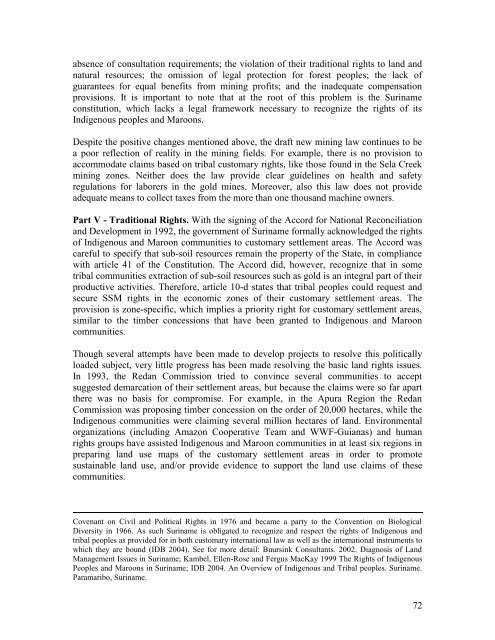SITUATION ANALYSIS OF THE SMALL-SCALE GOLD ... - WWF
SITUATION ANALYSIS OF THE SMALL-SCALE GOLD ... - WWF
SITUATION ANALYSIS OF THE SMALL-SCALE GOLD ... - WWF
You also want an ePaper? Increase the reach of your titles
YUMPU automatically turns print PDFs into web optimized ePapers that Google loves.
absence of consultation requirements; the violation of their traditional rights to land and<br />
natural resources; the omission of legal protection for forest peoples; the lack of<br />
guarantees for equal benefits from mining profits; and the inadequate compensation<br />
provisions. It is important to note that at the root of this problem is the Suriname<br />
constitution, which lacks a legal framework necessary to recognize the rights of its<br />
Indigenous peoples and Maroons.<br />
Despite the positive changes mentioned above, the draft new mining law continues to be<br />
a poor reflection of reality in the mining fields. For example, there is no provision to<br />
accommodate claims based on tribal customary rights, like those found in the Sela Creek<br />
mining zones. Neither does the law provide clear guidelines on health and safety<br />
regulations for laborers in the gold mines. Moreover, also this law does not provide<br />
adequate means to collect taxes from the more than one thousand machine owners.<br />
Part V - Traditional Rights. With the signing of the Accord for National Reconciliation<br />
and Development in 1992, the government of Suriname formally acknowledged the rights<br />
of Indigenous and Maroon communities to customary settlement areas. The Accord was<br />
careful to specify that sub-soil resources remain the property of the State, in compliance<br />
with article 41 of the Constitution. The Accord did, however, recognize that in some<br />
tribal communities extraction of sub-soil resources such as gold is an integral part of their<br />
productive activities. Therefore, article 10-d states that tribal peoples could request and<br />
secure SSM rights in the economic zones of their customary settlement areas. The<br />
provision is zone-specific, which implies a priority right for customary settlement areas,<br />
similar to the timber concessions that have been granted to Indigenous and Maroon<br />
communities.<br />
Though several attempts have been made to develop projects to resolve this politically<br />
loaded subject, very little progress has been made resolving the basic land rights issues.<br />
In 1993, the Redan Commission tried to convince several communities to accept<br />
suggested demarcation of their settlement areas, but because the claims were so far apart<br />
there was no basis for compromise. For example, in the Apura Region the Redan<br />
Commission was proposing timber concession on the order of 20,000 hectares, while the<br />
Indigenous communities were claiming several million hectares of land. Environmental<br />
organizations (including Amazon Cooperative Team and <strong>WWF</strong>-Guianas) and human<br />
rights groups have assisted Indigenous and Maroon communities in at least six regions in<br />
preparing land use maps of the customary settlement areas in order to promote<br />
sustainable land use, and/or provide evidence to support the land use claims of these<br />
communities.<br />
Covenant on Civil and Political Rights in 1976 and became a party to the Convention on Biological<br />
Diversity in 1966. As such Suriname is obligated to recognize and respect the rights of Indigenous and<br />
tribal peoples as provided for in both customary international law as well as the international instruments to<br />
which they are bound (IDB 2004). See for more detail: Buursink Consultants. 2002. Diagnosis of Land<br />
Management Issues in Suriname; Kambel, Ellen-Rose and Fergus MacKay 1999 The Rights of Indigenous<br />
Peoples and Maroons in Suriname; IDB 2004. An Overview of Indigenous and Tribal peoples. Suriname.<br />
Paramaribo, Suriname.<br />
72
















